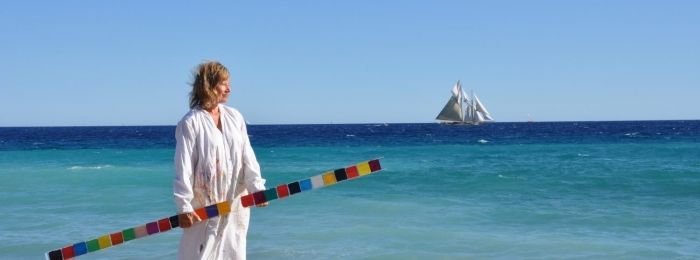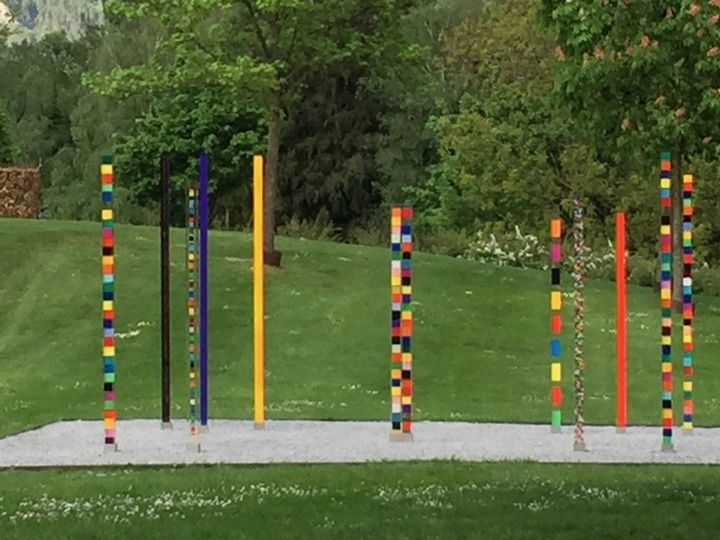
Susi Kramer's World
Triennale Bad Ragartz, Cube 240 x 240 x 240 cm

Fröhlichkeit umschreibt wohl das Wesen von Susi Kramer am besten, und diese spiegelt sich auch in ihrem Werk wieder, das von Farben, Licht und Transparenz lebt, gepaart mit einer unbändigen Neugier und Experimentierlust. Bei praktisch jedem Ausstellungs- oder Atelierbesuch gibt es Interessantes zu entdecken, neue Formen, neue Materialkombinationen.
Susi Kramer hat eine eigene, einfache Formensprache entwickelt, mit Punkten, Spiralen, Farbflächen, kleinen Figuren, Kronen und Engeln, die wie Piktogramme immer wieder auftauchen und jeweils aus reinen, monochromen und ungemischten Farbflächen bestehen. Sie nutzt diese einzeln oder kombiniert sie als Farbpunkte zu ganzen leuchtenden Gemälden. Ihre Farbpalette erinnert dabei an die französische Mittelmeerküste, mit den Blau- und Türkistönen des Himmels und des Meeres, dem Orange und Rot der südfranzösischen Böden und den klaren Sommerfarben dieser Gegend, von der sich schon zahlreiche Künstler angezogen fühlten. Es ist deshalb wohl kein Zufall, dass Susi Kramer ein Atelier in einem Turm hoch über Cannes besitzt, und sich dort inspirieren lässt.
Bei allen verschiedenen Materialien, die sie benutzt, gehört ihre Leidenschaft besonders dem Acrylglas. Vor einigen Jahren hat sie diesen Werkstoff für sich entdeckt und seither bildet er das Rückgrat ihres Kunstschaffens. Zuerst hat sie lediglich einzelne Farbflächen und Figuren in Acrylglasobjekte eingegossen, doch bald beginnt sie, mehrschichtige Flächen in ein Glasobjekt zu integrieren, um bei dem Betrachter Bilder zu erzeugen, die zusätzlich von verschiedenen Lichtverhältnissen und Perspektiven leben. Immer komplexere Werke, wachsende Stelen, Friese und Kuben entstehen, in denen dreidimensionale Farbobjekte eingebettet sind. Trotz dieser gesteigerten Ansprüche an Technik, Produktion und Schöpfungskraft verlieren die Werke ihre Fröhlichkeit und Leichtigkeit nie, die Stelen stehen wie positive Obelisken mit ihren Piktogrammen in der Landschaft. Susi Kramer interessiert sich sehr für produktionstechnische Fragen und experimentiert mit Formen und Materialien. Tüllstücke oder organische Elemente werden in Acrylglas gegossen ebenso wie Aeste von Buchsbüschen, die sie zum Teil vorher vergoldet, Knochen aus archäologischen Funden oder Herbstlaub.
Kunsthistorisch einordnen lässt sich die quirlige Künstlerin nur sehr bedingt und sie beruft sich kaum auf Vorbilder. Natürlich erinnert die Farbigkeit an Pop Art. Die Figuren sind im Surrealismus oder bei Art brut anzutreffen und Piktogramme oder Sprachzeichen in der Kunstgeschichte. Doch Susi Kramer hat sich eine eigene Welt erschaffen, in der sie agiert und ihre Werke arrangiert. Ihre Inspirationen findet sie im Alltäglichen, in der Natur.
Die Aargauer Künstlerin hat bereits an zahlreichen Orten gearbeitet, von Teheran über Hongkong bis Paris und fand mit Cannes einen zweiten Wohnort als wichtiges Lebenszentrum. Trotzdem ist sie stark in ihrer Heimat verwurzelt und besitzt zusammen mit ihrem Gatten Hans in Oberhof nebst Atelier ein Refugium mit Garten. Die vorliegende Monographie lädt den Leser ein, die verschiedenen Stationen, die gleichsam Lebensabschnitte und künstlerische Phasen bilden, zu entdecken. Von der jugendlichen Susi, die unbedingt Künstlerin werden wollte und sich durch nichts abbringen liess, bis zum heutigen vielfältigen Werk. Dabei bleibt klar, dass es sich nur um eine Momentaufnahme handelt, ist doch zu erwarten, dass es auch beim nächsten Ausstellungs- oder Atelierbesuch wieder etwas Neues zu entdecken gibt, und dies wohl noch lange.
Dominique Mollet
Cheerful is likely the best description of Susi Kramer’s character, an attribute that the color, light and transparency of her work well reflect. And that cheerfulness is matched by an unbounded curiosity and interest in experimentation. Anyone visiting one of her exhibitions or atelier almost always discovers something new, whether in forms of composition or combinations of materials.
Susi Kramer developed her unique visual vocabulary of simplistic dots, spirals, colored spots, small figures, crowns, and angels that − much like pictograms − recur again and again in purely monochromatic, undiluted colors. She uses each motif individually, or combines them as points of color in wholly luminous paintings. Her palette not only recalls the French Mediterranean coast with its blue and turquoise tones of sky and sea, but also the orange and reds of the soil and clear summer colors in Southern France that have drawn generations of artists before her. It’s no surprise to find that Susi Kramer has a studio in a tower high above Cannes, and draws inspiration from those surroundings.
Of the various materials she uses, acrylic glass is the one she enjoys working with most. Having discovered it only some years ago, she has since made it the mainstay of her art. While initially, she simply cast single color fields and figures into acrylic glass objects, she began in short order to integrate many-layered surfaces into her pieces. That innovation enabled viewing straight through the piece and the generation of three-dimensional images that, depending on the light conditions and perspective, come to vibrant life. Her work becomes increasingly complex, as towering steles, friezes, and cubes are the matrix into which three-dimensional objects are embedded. Despite the artist’s increased demands on technology, production, and creative power, the works never forfeit any of their cheery playfulness, and the steles stand like proud pictogram-decorated obelisks in the landscape. Susi Kramer is keenly interested in manufacturing technologies and experiments with forms and materials. Just so, a piece of fine tulle or organic materials – such as gold-painted boxwood twigs, small bones from a archeological dig, or autumn leaves – might suddenly appear in her vocabulary.
Art historically, it is hard to categorize her vibrant position, since her work shows little resemblance to that of artists who preceded her.
The colors, of course, suggest a Pop Art palette, the figures remind us of those of Surrealism or those in Art Brut, and the pictograms are found in various places in the annals of art. Yet Susi Kramer has created her own unique genre in which to operate and order her works. She draws inspiration from daily life or nature, often experimenting with acrylic glass combined with diverse elements, and opens up to the viewer a whole range of playfully new facets of this fascinating material.
Hailing from Canton Aargau, the artist has worked in locations as varied as from Tehran to Hong Kong, and has a second and important domicile in Cannes. Nonetheless, she is strongly rooted in her homeland and in Oberhof, where along with her atelier, she and her husband, Hans, enjoy a quiet refuge with a garden.
The monograph in hand invites the reader to discover the diverse stations that have counted among the stages in her life and artistic development. And that, from work by the youthful Susi − committed from an early age to being an artist and who let nothing dissuade her from that pursuit − to what is today’s many-faceted oeuvre. Even if this show is but a snapshot of her work, one can expect that at the next exhibition or atelier visit, something else new to discover will present itself, and that holds promise for a long time to come.
Dominique Mollet

Triennale Bad Ragartz, Stelen


